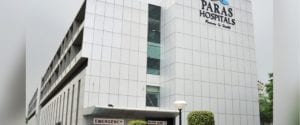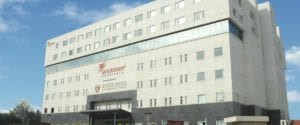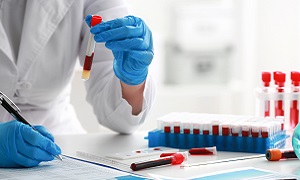Best Doctors in India for Endovascular Aneurysm Repair (EVAR) Treatment
Best Hospitals in India for Endovascular Aneurysm Repair (EVAR) Treatment
Paras Hospital, Gurugram
- City: Gurugram, India
Hospital Highlights:
- Paras hospital was established in 2006 and is the 250 bedded flagship hospital of Paras Healthcare.
- The is supported by a team of doctors of international and national repute.
- The hospital is NABH accredited and also the first hospital in the region to have a NABL accredited laboratory.
- The hospital provides specialty medical services in around 55 departments including Neurosciences, Joint Replacement, Mother & Child Care, Minimal Invasive Surgery, Gynecology and Obstetrics, Ophthalmology, Dermatology, Endocrinology, Rheumatology, Cosmetic and Plastic surgery.
- The hospital is equipped with state-of-the-art technologies.
S L Raheja Hospital, Mahim, Mumbai
- City: Mumbai, India
Hospital Highlights:
- SL Raheja hospital is a 140-bed multi-specialty tertiary care hospital that is being managed by Fortis Healthcare Ltd.
- The hospital is a benchmark in healthcare and medical facilities in the neighborhood of Mahim & the western suburbs.
- L.Raheja Hospital, Mahim has one of the most effective ICU and Casualty care services.
- The hospital provides specialty medical services in Cardiology, Oncology, Neurology, Orthopedics, Mother & Child Care, and in Diabetes.
Wockhardt Hospitals, Mumbai
- City: Mumbai, India
Hospital Highlights:
- Wockhardt Hospitals were established in the year 1973, originally called First Hospitals and Heart Institute.
- Wockhardt Hospitals are super specialty health care networks in India, nurtured by Wockhardt Ltd, India’s 5th largest Pharmaceutical and Healthcare company.
- Wockhardt Hospitals is associated with Partners Harvard Medical International, an international arm of Harvard Medical School, USA.
- Wockhardt Heart Hospital performed India’s first endoscopic heart surgery.
- The hospital has a state-of-the-art infrastructure equipped with the latest technologies and modern equipment.
- It has special Centers of Excellence dedicated to the major specialties to provide hassle-free and high-quality clinical care.
Pushpawati Singhania Hospital & Research Institute, New Delhi
- City: New Delhi, India
Hospital Highlights:
- Established in 1996, Pushpawati Singhania Research Institute is one of the top hospitals in the NCR region, as well as one of the top facilities in India for gastroenterology. The hospital is one of South Asia’s first institutes in medical and surgical treatment for diseases related to digestion.
- The hospital is equipped with state-of-the art facilities coupled with the latest equipment as well as renowned consultants from various parts of India as well as other parts of the world.
Indian Spinal Injuries Center, New Delhi, India
- City: New Delhi, India
Hospital Highlights:
- The Indian Spinal Injuries Center (ISIC), provides state-of-the-art facilities for the management of all types of spinal ailments.
- Staffed with internationally trained, acclaimed, and dedicated spine surgeons, the hospital provides cutting-edge medical & surgical technology. The hospital provides comprehensive management of spinal injury, back pain, spinal deformities, tumors, osteoporosis, etc.
- The hospital performs motion-preserving spine surgeries including disc replacement and dynamic fixation, and minimally invasive spine surgeries such as endoscopic disc excision.
- The orthopedic service of the hospital covers all orthopedic ailments including trauma, joint diseases & replacements, oncology, pediatric orthopedics & upper limb ailment.
W Pratiksha Hospital, Gurgaon
- City: Gurugram, India
Hospital Highlights:
- W Pratiksha Hospital, Gurugram, is one of the best hospitals in the NCR region. It is also a top hospital in India for IVF. Since its inception, the hospital has performed over 5500 successful IVFs. The hospital also specializes in gynecology.
- With over 20 years of experience in providing quality healthcare, the hospital is known as one of the most trusted and valued health providers in India.
- Equipped with world-class medical facilities and advanced technology, the hospital’s doctors and clinicians also have a track record of delivering excellent results. The hospital is also known for focusing on preventive well-being as much as on curative treatment.
- The hospital has earned the trust of its patients, by providing the best available treatments at affordable costs.
Narayana Superspeciality Hospital, Gurugram
- City: Gurugram, India
Hospital Highlights:
- Situated near DLF Cyber City, Gurugram, Narayana Superspecialty Hospital is one of the top medical facilities in the Delhi NCR region, catering to the needs of the people. Known for its commitment to quality medical care and patient service, the hospital is a state-of-the-art facility with planned and well-equipped sections, which includes a spacious OPD area as well as comfortable patient rooms.
- It is the closest super-specialty hospital from Indira Gandhi International Airport towards Gurugram, and also the nearest super specialty hospital from DLF Cyber City. It is also close to major residential areas in Gurugram.
- It is part of the renowned Narayana Health Group. Established in 2000, by Dr. Devi Shetty, a renowned cardiac surgeon, it has grown to be one fo India’s leading healthcare groups.
Sir Ganga Ram Hospital, New Delhi
- City: New Delhi, India
Hospital Highlights:
- Sir Ganga Ram Hospital, New Delhi is known to provide the latest medical procedures with the latest technology in all of its units.
- The hospital has a team of reputed doctors, nurses, and healthcare professionals that ensure that patients receive quality care at affordable costs.
- Staffed with a team of highly qualified doctors, dedicated nurses, and paramedical and non-medical staff, the hospital aims to lead in healthcare delivery, medical education, training, and research.
- As per the vision of the founder, the hospital also provides free treatment to the economically weaker sections of society.
- Sir Ganga Ram Hospital also provides training to young doctors under the Diplomate in National Board(DNB) program. The DNB program at the hospital was started in 1984 and it is known for currently running the maximum number of DNB specialties in the country. It also has the distinction of having the first bone bank in India.
KIMS Hospital, Hyderabad
- City: Hyderabad, India
Hospital Highlights:
- KIMS Hospital (a brand name of Krishna Institute of Medical Sciences) is one of the largest and best multi-speciality hospitals in Hyderabad. The hospital provides various treatments to an enormous number of patients.
- The hospital has a capacity of more than 3000 beds. KIMS Hospitals offers different healthcare services in more than 25 specialities and super specialities.
- The hospital is equipped with modern medical equipment and technology. It has robotic equipment to provide minimal invasive techniques for patients.
- The hospital is aimed at providing world-class healthcare facilities and services at an affordable cost for patients.
- The various specialities and departments of the hospital include neurosciences, gastroenterology & hepatology, robotic science, reproductive sciences, dental science, oncological sciences, organ transplantation, heart and lung transplantation and mother and child care.
Fortis Hospital, Shalimar Bagh
- City: New Delhi, India
Hospital Highlights:
- Fortis Hospital in Shalimar Bagh is a multi-super specialty hospital that strives to provide world-class patient care by leaving no stone unturned.
- Fortis, Shalimar Bagh, with 262 beds and a 7.34-acre footprint, provides the best level of medical care through its team of doctors, nurses, technicians, and management professionals.
Endovascular Aneurysm Repair (EVAR)
Endovascular aneurysm repair or EVAR is a procedure for treating an aneurysm or abnormal enlargement of the abdominal aorta. When the abdominal aorta gets enlarged, there are generally two ways to perform surgery. It might be performed through an open incision or in a minimally-invasive procedure known as endovascular aneurysm repair.
This technique has an advantage, which is that there is no abdominal surgery. This makes this technique safer than the traditional open surgery and you also need to spend lesser time at a hospital.
Purpose
The largest artery in your body is the aorta. It helps to transport blood from your heart to various other body parts. When the aorta runs through the chest, it is known as thoracic aorta and when it reaches the abdomen, it is called as the abdominal aorta. This aorta helps supply blood to the lower parts of your body. The normal diameter of this aorta is around 1 inch or 2 cm. However, when it gets weakened or stretched, then it might expand or bulge. This condition is known as abdominal aortic aneurysm. When this aneurysm is over 5.5 cm, this increases the risk of a rupture and your doctor might consider a surgery.
Preparation
First your doctor will explain you how the procedure is done and you will have the opportunity to ask any questions that you might have. Your doctor might need to examine your medical history to ensure that you are in good health. You might also need to undergo blood tests as well as other diagnostic tests.
You will be asked to fast for a minimum of eight hours before your procedure, generally after midnight.
You should notify your doctor if you are pregnant, or if you think you might be. You should also let your doctor know about any medications that you are taking.
If you have a history of bleeding disorders, or if you are having anticoagulant medications, then it might be necessary for you to stop taking these medications. If you smoke, you will need to stop it as soon you can before the procedure. Smoking can interfere with your chances of having a successful recovery from the surgery and to improve your overall health status.
The areas of your surgical site might require shaving before the procedure.
Procedure
Procedures might vary depending on your condition, as well as on the skills and experience of your doctor.
First you will need to lie on your back on the procedure table. Then your heart rate will be continuously monitored. Once you are sedated with anesthesia, a breathing tube is likely to be inserted through your lungs. You will be connected to a ventilator, which will help you in breathing throughout the surgery.
Your surgeon will make an incision in each groin, to expose the femoral arteries. Using a method known as fluoroscopy, he will be inserting a needle into the femoral artery through which a guidewire is going to be passed and advanced to the aneurysm site.
Then he/she will inject contrast dye to visualize the position of the aneurysm and its adjacent blood vessels. After this, he/she will use special endovascular instruments and X-ray images for guidance. A stent-graft is then going to be inserted through the femoral artery, and will be advanced up into the aorta to the site of the aneurysm. It will be expanded and attached to the wall of the aorta.
An aortogram is going to be done to check for an endoleak, i.e. blood leaking out into the aneurysm sac of the stent graft. Once it is determined, that there is no leak, the instruments are going to be removed.
Then the incisions are going to be sutured back together, and the doctor will apply a bandage or a dressing.
Recovery
Depending on your condition, you may or may not be sent to the ICU. However, it is likely that you are going to be taken to a post-anesthesia care unit. You are going to be connected to monitors that will be constantly displaying your ECG tracing, blood pressure, breathing rate, your oxygen level as well as other pressure readings.
If you experience any pain, you will receive the appropriate medicines.
Slowly, you will be able to increase your daily activities gradually.
Once you are home, make sure that you keep the surgical site clean and dry. You will receive instructions from your doctor regarding this. If the sutures or surgical staples were not removed before you left the hospital, they will be removed during a follow-up office visit.
You should not drive unless your doctor tells you to.
If you experience fevers or chills, redness, swelling or bleeding at the incision site, or increase in pain around the incision site, then you need to notify your doctor soon.
Risks
There is a small risk that you might experience any of the following after the surgery:
- Heart attack
- Kidney failure
- Chest problem
- Stroke
- Loss of circulation in your legs or bowel
- Infection in the graft which was used to replace your aorta
A small percentage of men might also have difficulty in sustaining an erection after the surgery. If you experience you should inform your doctor, as there are treatments that are able to help.
Another recognized risk is deep vein thrombosis, which most patients can experience during the stay at the hospital. Your surgeon can recommend a treatment to prevent this.
It is best to discuss all risks and possible complications with your surgeon, before you undergo the surgery.













